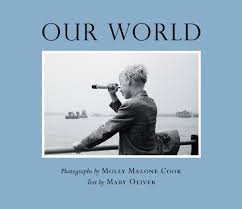 Our World
Our World
Photographs by Molly Malone Cook
Text by Mary Oliver
Beacon Press. 90 pages, $24.95
IN OUR WORLD, Mary Oliver writes of her longtime partner, photographer Molly Malone Cook: “M. had will and wit and probably too much empathy for others; she was quick in speech and she did not suffer fools … you had to be brave to get to know her.” I certainly felt all of those qualities during a brief exchange I had with Cook back in 1997, and this is just one of the wonderfully precise descriptions threaded throughout Our World, a collection of Cook’s striking black-and-white photographs, which Oliver has generously annotated with succinct, insightful memoirs about her late partner, who died in 2005.
Molly Malone Cook was put up for adoption just after her birth in San Francisco in 1925. Though Cook did eventually find and meet her birth parents, her difficult beginning can account for some of the more somber qualities that Oliver describes: “She was style, she was an old loneliness that nothing could quite wipe away. … She lived sometimes in a black box of memories and unanswerable questions, and then would come out and frolic—be feisty, and bold.”

This introspection and boldness can be found in equal measure in the fifty photographs that Oliver has selected for inclusion in this new volume. Many of Cook’s early photos, some of which were taken when she was working as a personnel officer for the U.S. Army, are candid portraits of solitary children, playing or sitting alone. Like any true portrait photographer, Cook captures a look in these children’s eyes that seems to convey an entire story, while still retaining the requisite element of human mystery.
Among the most arresting of those candid portraits is “Boy with Telescope,” a late-1950’s photo that serves as the book’s cover image. A young blond boy on the deck of a New York City cruise ship peers through a hand-held scope into the distance outside of the frame, across the city’s harbor. In many ways, it couldn’t be a kinder, gentler image of the American ideal itself, an earnest search for liberty, possibility, and destiny. Cook traveled all over the country, finding faces to photograph in Mississippi, New Mexico, and Montana, while other images reflect her wider travels and span the European continent, from France to Germany to Italy.
Cook also worked as a photographer for The Village Voice in the earliest days of that publication, so a number of famous faces from that era can be found in her photographs: Jean Cocteau, playwright Lorraine Hansberry, Eleanor Roosevelt, artist Robert Motherwell, Norman Mailer. Elsewhere, the photos highlight Cook’s humor (a man at a wine tasting, who looks more than a little sloshed, stands directly below a sign that reads “tasting ends here”), as well as her otherworldly tenderness (a silver spoon of water that’s being held up to the beak of a small bird, delicately perched on a woman’s hand).
After Cook met Oliver at the poet Edna St. Vincent Millay’s estate in upstate New York, the couple eventually settled down together in Provincetown. In the early 1960’s, Cook opened her own photography gallery there, selling prints by the still obscure Ansel Adams, among others, for just $35 apiece. The photo gallery proved not to be financially viable in that era, so Cook and Oliver then ran Provincetown’s East End Bookshop (where the young filmmaker John Waters infamously worked as a clerk) until 1969, when Cook’s health began to show the first signs of its gradual decline.
The Provincetown section of Our World is special not only thanks to Cook’s images of various painters, writers, and town denizens of the day, but also because of Oliver’s elegant prose snapshots of an authentically bohemian lesbian romance. Such a relationship—in which the artistic couple without much income gathered food for free from the woods and the ocean, looking to each other for sustenance otherwise—is obviously a rarity, if not nonexistent in today’s culture. While it’s devastating to think that we may have lost that particularly unique mode of living, Our World presents the art that arose from it, and from two women’s deeply entwined lives.
Jason Roush, author of After Hours and Breezeway, teaches at Emerson College.





